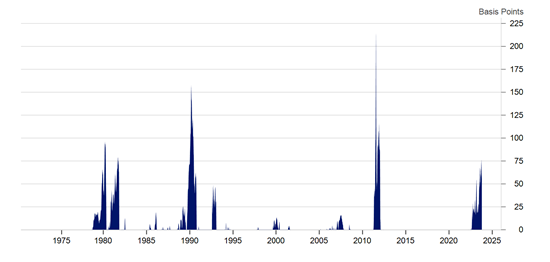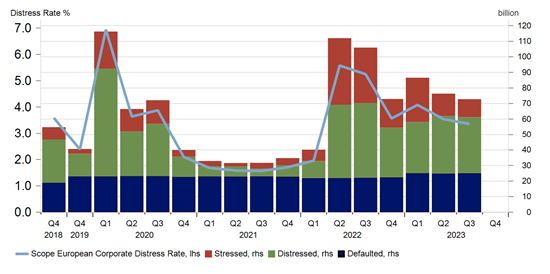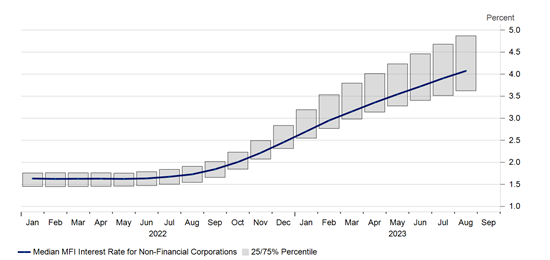Announcements
Drinks

Credit Lines: long tail risks emerge as rising yields collide with geopolitical tensions

The cumulative fall-out of geopolitical events in recent years has already crystallised a tail event in bond markets, where yield curves first shifted up in 2021 from record low levels during the pandemic, then heavily inverted in response to central banks’ efforts to contain rising inflation in 2022, and recently started to bear flatten in anticipation of a prolonged period of elevated rates.
Looking back at the available history of yield curve inversions since the 1970s, it becomes apparent that the current bond bear market very much qualifies as a tail event.
Sharply rising yields across an inverted curve are a tail event
Leaving aside the 2012 episode of inverted credit curves for certain euro area sovereigns, we have to go back to the inflationary years of the 1980s and 1990s to observe increases in yield of a similar magnitude during periods of inversion. History also shows that these episodes tend to be short-lived as usually some crisis takes place happens that prompts yields to fall, most dramatically after the global financial crisis more than a decade ago.
Global bond markets during periods of inverted and rising yield curves

Source: Macrobond, Scope Calculations
Investors need to consider weakening early cycle indicators such as sentiment surveys and still strong late-cycle signals from labour markets in assessing how long the current market environment can persist. These conflicting signals are further confused the opposing inflationary forces of weak economic impetus due to disruptions to trade and high and volatile energy prices, helping keep monetary policy tight.
Reduced central bank bond buying underpins higher-rates-for-longer view
In addition, reduced central bank asset purchases mean that the net supply of government bonds will remain high while liquidity in the banking system is shrinking and credit standards are tightening. So, it is hardly surprising that, given so many moving parts, the consensus is for rates to remain at least where they are if not higher, i.e., higher and longer.
This assumption is not without consequence for the credit channel. Up to now, the most interest rate sensitive sectors such as residential and commercial real estate have taken the biggest hit from deteriorating asset values and rising yields.
As Philipp Wass, executive director in corporate ratings, wrote in a report earlier this month:
Deleveraging through asset sales is essential for most issuers to meet creditors’ expectations of de-risked balance sheets. However, this confronts the sector with a potentially vicious circle given the danger that the selling will only be possible at valuations below latest appraisals, thus leading to a sharp drop in asset values, further weakening balance sheets.
Philipp noted that Europe’s real estate firms face a 40% rise in aggregate bond refinancing to EUR 45bn in 2026 from EUR 32bn next year. With high interest rates set to prevail and multiple pressures for more investment, access to funding is vital to protect credit quality.
European corporate distress rate remans elevated

Source: Bloomberg, Scope calculations
Corporate defaults climb in Europe, beyond the post-Covid adjustment
However, higher refinancing cost are creeping into the equation across the economy. Governments are losing fiscal space, as Jakob Suwalski and Brian Marly, analysts in sovereign and public sector ratings at Scope, have pointed out.
An extended period of higher euro area interest rates is testing governments’ debt management as financing costs rise, adding urgency to the need for fiscal reforms to create space for higher social spending and green investment.
At the same time, household incomes are affected by higher mortgage payments as floating rate contracts reset and fixed-rate terms run off.
Corporate borrowing cost rise across euro area

Source: ECB, Scope Calculations
European corporate default rates look many months from levelling off
On the corporate front, those firms which have retained good access to capital markets and bank lending still face coupons on new debt and floating loan facilities that are substantially higher, reducing the incentive to invest. High-yield defaults are already on the rise as are small company defaults as weaker borrowers struggle to accommodate tighter financial conditions, as Sebastian Zank, deputy head of corporate ratings at Scope, wrote earlier this month.
Rising default rates are more than just a normalisation of the credit environment in Europe after the pandemic. They reflect substantially increased risks as higher-for-longer interest rates exacerbate pressures on corporate balance sheets in many sectors.
Sebastian reckons that companies will continue to default in growing numbers in Europe at least until late 2024 and early 2025.
Thus, it is fair to assume that, in line with historical experience, the tail of spiking yields will eventually correct.
Let’s hope we don’t need too much of a crisis for that to happen.





